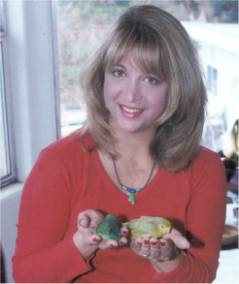Hi Sandee,
I am looking for a blue dominant pied female to pair with my green/blue male
who is about 4 months old. In the future, I would also like to add some
other mutations such as pastel, ino's, or fallow. I currently have two pair
of breeders that I bought as a proven pair. They have both produced
beautiful babies, but the baby's mutations don't match the outcome for what
I was told the parent's are. I really would like to put together young,
healthy pairs without any hidden splits, but I am having a very hard time
finding breeders offering these birds. I am hoping you may be able to help.
:)
Kelly
Thanks Kelly but I specialize in rare and uncommon species not the latest
color mutations. I do breed fallows but have none available and don't know
when they will be breeding as I put my birds' on hold for 2 years while I
cared for my mother who died of cancer. They have not show interest in
breeding and I suspect, since I've been doing this for almost 30 years, that
it will take a long time to get them interested again. Sorry.
Please remember that its not always the breeders' fault when it comes to not
knowing what is in the background of these birds since all the color
mutations, except dilute, were imported from Europe and their backgrounds
were unknown. I do have a blog about that at
http://parrotletblog.blogspot.com/ that gives the history of these birds and
the reasons some colors are produced.
Best of luck!
Sincerely yours,
Sandee L. Molenda, C.A.S.
Thanks Sandee. I look forward to reading your blog. Is there a new violet mutation? (Well, it is new to me anyway). I will continue to learn all I can about these wonderful birds. Maybe someday I will have a true rare mutation. In the mean time, I really love the pied parrotlets and will continue to look for my little pied hen. :)
I am very sorry to hear about your mother. I work for a Home Care company and just recently care for a gentleman who passed away from cancer. Your mom was very blessed to have you to take care of her. I hope your birds decide to bless you real soon with new babies.
Kelly
Thank you Kelly. You are very sweet and I'm sure my birds will breed again. I've been doing this for almost 30 years so I know my birds better than myself. Its people that can be the problem - no one has patience anymore. So I just as soon not take any names or give people times as to when the birds will be available because I simply don't know. Another thing people are reluctant to admit these days - they don't know. :) Especially online - everyone with a keyboard is an 'expert'.
As for the violet mutation I'm sure there is one in Europe an you're correct 'new' is a relative term. The Europeans are light years ahead of Americans when it comes to producing new mutations. As for 'rare mutations', again it is a relative term. What is 'rare' in the US is probably very common in Europe. In reality, no mutation is rare because they can always be reproduced and, unlike species, they can be imported. The US has tons of color mutations these days but even what used to be 'common' species like Green Rumps and Spectacleds, are becoming more and more rare. Species such as Mexicans, Yellow Face and Blues Wings are pretty much genetically extinct in this country. Very sad. I always tell people that 'mutations' are man-made but only God can make a species.
Glad to be of help!
Sincerely yours,
Sandee L. Molenda, C.A.S.
Sunday, August 22, 2010
Color Mutation Pacifics
Subscribe to:
Post Comments (Atom)




No comments:
Post a Comment
Note: Only a member of this blog may post a comment.